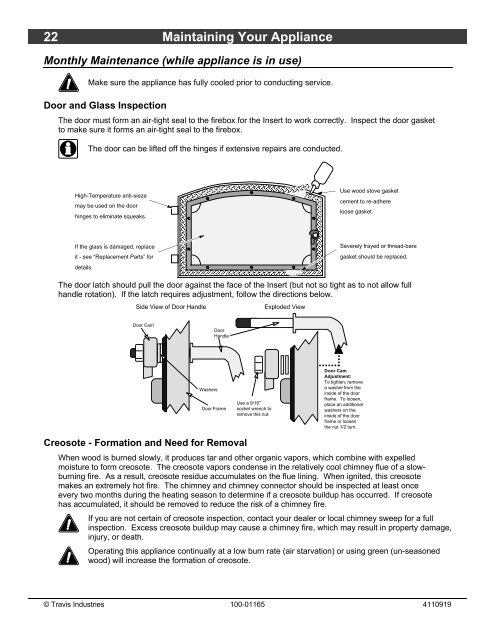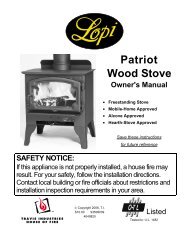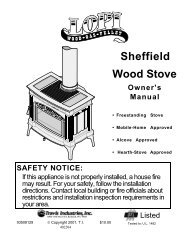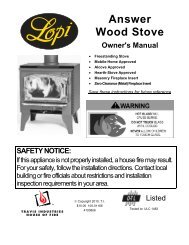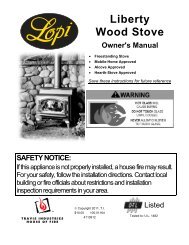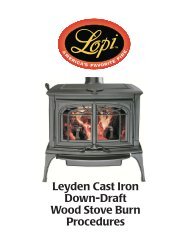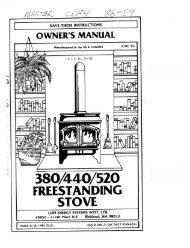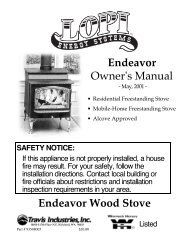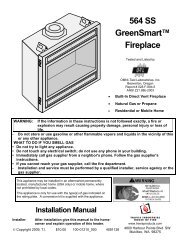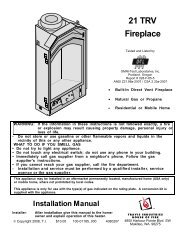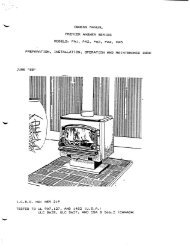Revere Fireplace Insert Owner's Manual - Lopi
Revere Fireplace Insert Owner's Manual - Lopi
Revere Fireplace Insert Owner's Manual - Lopi
Create successful ePaper yourself
Turn your PDF publications into a flip-book with our unique Google optimized e-Paper software.
22 Maintaining Your Appliance<br />
Monthly Maintenance (while appliance is in use)<br />
Make sure the appliance has fully cooled prior to conducting service.<br />
Door and Glass Inspection<br />
The door must form an air-tight seal to the firebox for the <strong>Insert</strong> to work correctly. Inspect the door gasket<br />
to make sure it forms an air-tight seal to the firebox.<br />
The door can be lifted off the hinges if extensive repairs are conducted.<br />
High-Temperature anti-sieze<br />
may be used on the door<br />
hinges to eliminate squeaks.<br />
If the glass is damaged, replace<br />
it - see “Replacement Parts” for<br />
details.<br />
The door latch should pull the door against the face of the <strong>Insert</strong> (but not so tight as to not allow full<br />
handle rotation). If the latch requires adjustment, follow the directions below.<br />
Side View of Door Handle<br />
Door Cam<br />
Creosote - Formation and Need for Removal<br />
<br />
<br />
<br />
<br />
<br />
<br />
<br />
Washers<br />
Door<br />
Handle<br />
Door Frame<br />
Use a 9/16"<br />
socket wrench to<br />
remove this nut.<br />
Exploded View<br />
Use wood stove gasket<br />
cement to re-adhere<br />
loose gasket.<br />
Severely frayed or thread-bare<br />
gasket should be replaced.<br />
Door Cam<br />
Adjustment:<br />
To tighten, remove<br />
a washer from the<br />
inside of the door<br />
frame. To loosen,<br />
place an additional<br />
washers on the<br />
inside of the door<br />
frame or loosen<br />
the nut 1/2 turn.<br />
When wood is burned slowly, it produces tar and other organic vapors, which combine with expelled<br />
moisture to form creosote. The creosote vapors condense in the relatively cool chimney flue of a slowburning<br />
fire. As a result, creosote residue accumulates on the flue lining. When ignited, this creosote<br />
makes an extremely hot fire. The chimney and chimney connector should be inspected at least once<br />
every two months during the heating season to determine if a creosote buildup has occurred. If creosote<br />
has accumulated, it should be removed to reduce the risk of a chimney fire.<br />
If you are not certain of creosote inspection, contact your dealer or local chimney sweep for a full<br />
inspection. Excess creosote buildup may cause a chimney fire, which may result in property damage,<br />
injury, or death.<br />
Operating this appliance continually at a low burn rate (air starvation) or using green (un-seasoned<br />
wood) will increase the formation of creosote.<br />
© Travis Industries 100-01165 4110919


